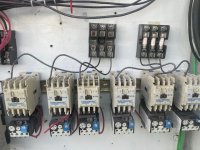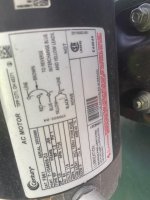Jpflex
Electrician big leagues
- Location
- Victorville
- Occupation
- Electrician commercial and residential
All we have at our company is 3 phase starters and the closest I have is a 3 phase 1/2 hp motor starter with what looks to be with an adjustable overload knob
The motor is a single phase 1/4 hp motor at 115 volts. The NEC FLC was 5.8 ampere
Is it proper to feed the three phase 1/2 hp (all we have but close size) motor starter from a 15 ampere time delay fuse to only L1 terminal of starter and exit T1 to motor
Then leave neutral unfused, not connected to starter terminals, but source neutral connected directly to motor neutral terminal?
The motor is a single phase 1/4 hp motor at 115 volts. The NEC FLC was 5.8 ampere
Is it proper to feed the three phase 1/2 hp (all we have but close size) motor starter from a 15 ampere time delay fuse to only L1 terminal of starter and exit T1 to motor
Then leave neutral unfused, not connected to starter terminals, but source neutral connected directly to motor neutral terminal?



